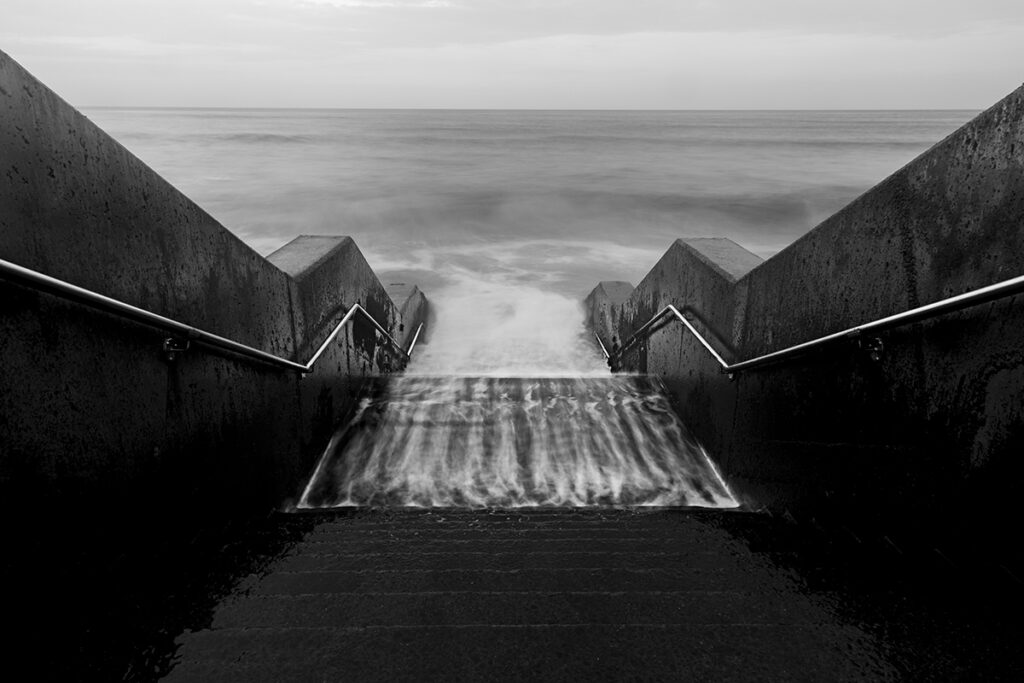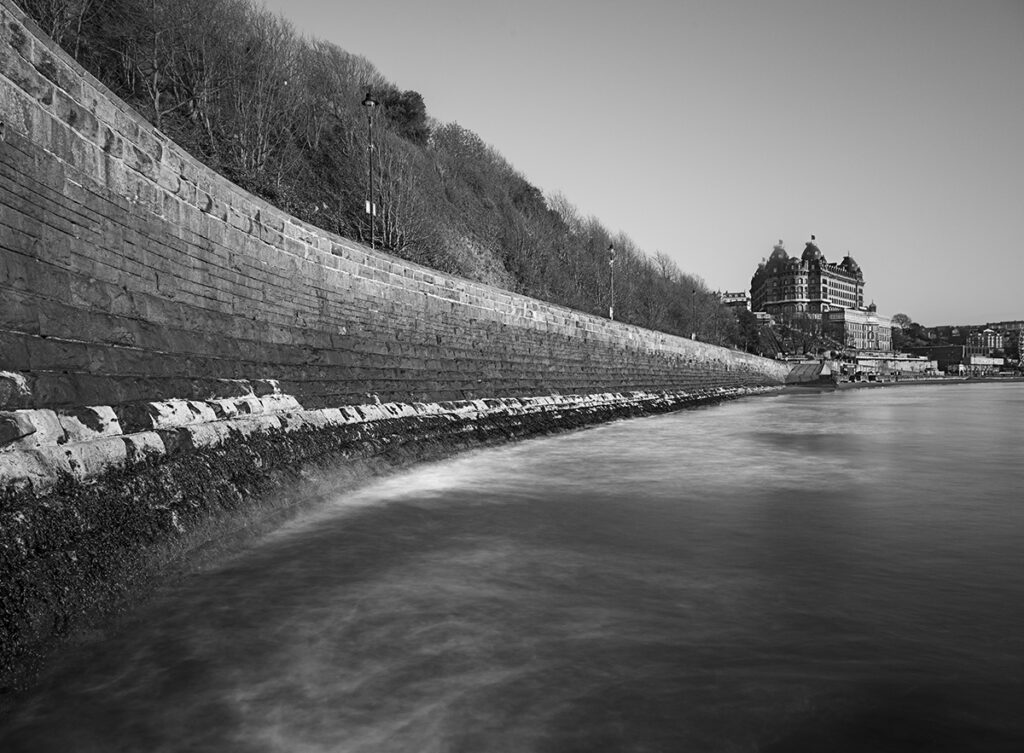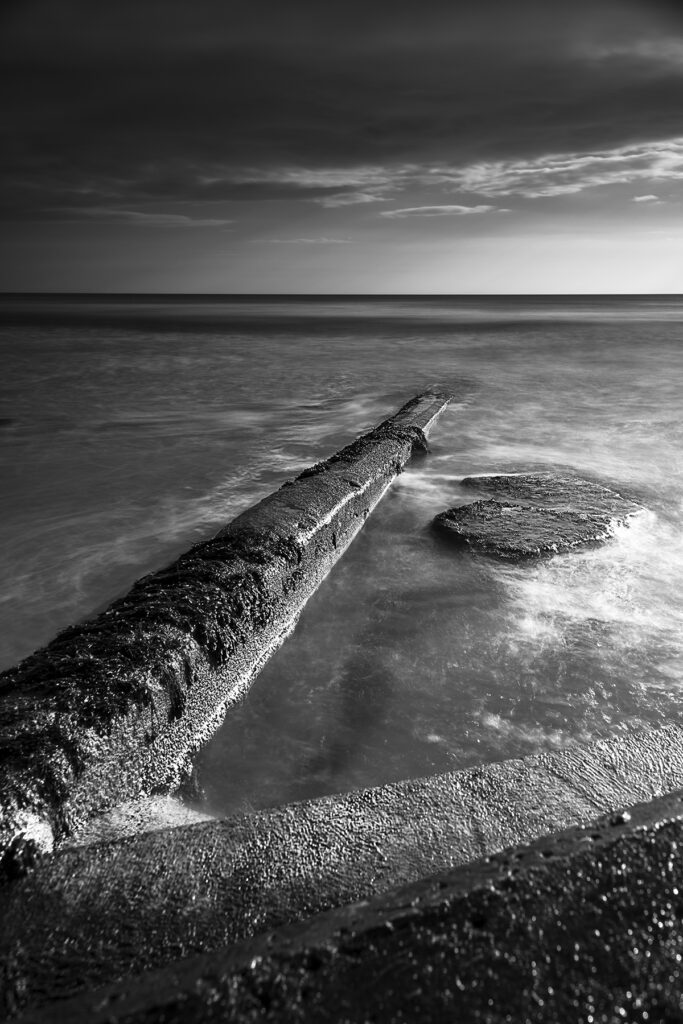Scarborough in Slow Motion: The Art of Long Exposure Coastal Photography
There’s something undeniably magical about waking up before the world stirs. As a photographer eternally chasing the perfect light, I find myself making these early morning sacrifices more often than not—especially when the Scarborough coastline is calling with its siren song of dramatic seascapes and historical architecture. The Yorkshire coast has a particular character that reveals itself only to those willing to greet it in the liminal hours between darkness and day.
Last weekend, I packed my trusty van—the perfect “rat camper” for landscape photography—and headed northeast from my home in Leeds. I stopped at a camp site in Scarborough overnight specifically to capture the early morning high tide. This unassuming vehicle has become my most valued photographic asset: compact enough to be parked on a sixpence in cramped coastal car parks, yet ingeniously converted with a fold-away mattress that sleeps two comfortably when needed. The abundance of charging points keeps all my camera batteries and devices fully powered, even during multi-day shooting expeditions. My mission was clear but challenging: to capture the ethereal quality of Scarborough’s shoreline at high tide, when the morning light remains gentle and the usual crowds are nothing but a distant thought.
The Decision to Camp: Embracing Discomfort for Art’s Sake
Most photographers will tell you that accommodation near popular shooting locations can be convenient but ultimately limiting. Hotels require check-in times, have fixed breakfast schedules, and rarely understand why you might need to leave at 4:00 AM with a tripod slung over your shoulder and a determined look in your eye. This is precisely why my van has become my secret weapon in landscape photography.
For this Scarborough trip, I stopped at a camp site in town overnight specifically to capture the early morning high tide. While I can sometimes camp in more remote locations, having a proper site provided peace of mind and allowed me to focus entirely on preparing for the dawn shoot. The stealth aspect of my unassuming van still proves invaluable—looking more like an ordinary work vehicle than a camping van, it allows me to blend in where more obvious motorhomes might attract attention.
This isn’t luxury camping by any measure—the van’s interior has been stripped back and customised with only essential amenities. The fold-away mattress takes just seconds to deploy, and when stowed, provides ample space for organising gear. A small portable stove nestles perfectly on the compact counter space, and the numerous charging points ensure that all my equipment remains fully charged throughout extended shoots.
The evening I arrived at the camper site, I spent time meticulously planning the next morning’s shoot from the comfort of my van. Armed with tide tables, weather forecasts, and the PhotoPills app on my fully-charged tablet, I plotted my course along the coastline. High tide was predicted for 5:47 AM—perfectly coinciding with the blue hour before sunrise at 6:22 AM. These convergences of natural phenomena are what landscape photographers live for.
I awoke at 4:30 AM to the distant sound of seagulls and the gentle patter of light rain on the van’s roof. Nevertheless, I dragged myself from the relative warmth of my sleeping bag, made a quick cup of instant coffee, and set out into the pre-dawn darkness equipped with headlamp, camera backpack, and the quiet determination that drives us landscape photographers to endure discomfort for our craft.
Sea Steps: A Gateway to the Infinite

By the time I reached the seafront, the rain had mercifully stopped, though the sky remained heavily overcast. This wasn’t necessarily disappointing—flat light can often be perfect for long exposure work, eliminating harsh contrasts and allowing textures to take centre stage. I made my way carefully down to the coastal steps near South Bay, guided by the beam of my headlamp and the rhythmic sound of waves growing louder as I approached.
As high tide pushed water through the concrete sea defences, I carefully set up my tripod on the slippery upper steps, weighing it down with my backpack for additional stability against the sea breeze. The technical challenges were immediate—keeping the lens free from spray, calculating exposure times in changing light, and maintaining perfect stillness of the camera during exposures.
After some experimentation with different compositions, I settled on this symmetrical view that uses the concrete walls as leading lines drawing the eye out to the misty horizon. As high tide pushed water through and over the steps, I began a series of long exposures. The final image required a 30-second exposure at f/11, ISO 100, with the Lee Big Stopper reducing the light to make such an exposure possible even as daylight strengthened. The magical transformation occurred before my eyes—what in reality was churning seawater became a smooth, foggy dreamscape.
During those seconds of exposure, I contemplated how these steps had witnessed countless tides, storms, and sunrises over the decades. In transforming this familiar Scarborough landmark through long exposure, I hoped to reveal something of its timeless quality that might otherwise go unnoticed by the casual observer.
The Historic Seawall: Where Victorian Engineering Meets Timeless Sea

With my first series of images captured, I began the trek along Marine Drive as the light strengthened. This stretch of Scarborough’s coastline has always fascinated me—it represents the Victorian determination to tame nature through engineering while simultaneously celebrating the awesome power of the sea through thoughtful design.
As I set up my tripod at what I judged to be the optimal position, I was struck by how the Victorian engineering of Scarborough’s sea defences creates a compelling visual dialogue with the natural elements surrounding it. The massive stone wall, built in the 1880s at considerable expense and engineering prowess, stands as testimony to an era when Scarborough was the crown jewel of the British seaside experience. In the distance, the Grand Hotel—once the largest hotel in Europe—stands proudly atop the cliff, a reminder of the town’s glamorous heyday.
This image required extraordinary patience and technical precision. Position was everything: too close to the wall and I’d lose the sweeping line leading to the town; too far away and the architectural detail would diminish. I waited nearly forty minutes for the right combination of tide level and light breaking through the morning clouds.
The technical challenges of this shot were considerable. The exposure time—approximately 30 seconds—smoothed the water’s surface into a glassy plane while maintaining the textural detail of the stone wall. This juxtaposition creates what I think of as a visual conversation between permanence and flux, between human ambition and natural force. I used a polarising filter in addition to my Lee Big Stopper for this shot, which helped to cut through the morning glare on the water’s surface and enhance the definition of the clouds.
As I worked, I couldn’t help but reflect on how Scarborough has reinvented itself over centuries—from medieval trading port to fashionable spa town, to Victorian seaside resort, and now to a complex mix of traditional seaside attractions and cultural renaissance.
Minimalism on the Shore: Finding Zen at Water’s Edge

By 6:45 AM, the high tide had reached its peak, and I found myself drawn to the northern end of North Bay where the shoreline becomes more rugged and less frequented by casual visitors. The light had changed dramatically—gaps in the cloud cover allowed shafts of early sunlight to penetrate, creating dramatic contrasts across the seascape.
It was here that I discovered this simple breakwater partially submerged beneath the high tide. What immediately struck me was its stark simplicity—a single linear element extending into the vastness of the North Sea. This is what attracts me to long exposure photography: its extraordinary ability to simplify a scene down to its most essential elements.
I spent considerable time finding exactly the right perspective for this shot. The final position required me to set up my tripod in about two inches of water, necessitating constant vigilance as the tide continued to shift unpredictably with the wind.
A 30-second exposure with the Lee Super Stopper transformed what was in reality a choppy, wind-affected sea into this serene, misty plane. The lapping waves became a soft mist surrounding the solid structure, while the distant horizon dissolved into an ambiguous boundary between sea and sky. I particularly appreciate how the linear concrete barrier anchors the composition while the water and sky merge into subtle gradients of grey.
During the long exposure, I found myself entering an almost meditative state—a common experience for long-exposure photographers who must often stand in silence waiting for their sensors to gather light. There’s something profoundly centring about this forced stillness in a world that rarely allows us to pause.
The resulting image represents for me the essence of contemplative photography—finding unexpected beauty in ordinary objects through careful observation and technical transformation. The concrete breakwater, utilitarian and unremarkable to passing visitors, becomes in this image something approaching poetry.
Technical Notes for Fellow Photographers
For those readers who share my passion for the technical aspects of photography, I’m happy to share the details behind these images. All were shot on my Canon 5D Mark IV DSLR with my trusty Canon EF 24-105mm f/4L IS USM lens. Though some photographers might prefer ultra-wide angles for coastal work, I find this versatile zoom range perfect for everything from expansive seascapes to more intimate compositions. The constant f/4 aperture combined with the excellent image stabilisation makes it an ideal companion for long exposure work in challenging light conditions.
The Lee Filters system proved essential. I alternated between the Lee Big Stopper (10-stop ND) and Super Stopper (15-stop ND) depending on the lighting conditions and desired exposure length. Despite the capability to shoot very long exposures, I found that for this particular Scarborough shoot, nothing beyond 30 seconds was needed to achieve the ethereal effect I was seeking. This reinforces my belief that successful long exposure photography isn’t necessarily about extreme exposure times but rather finding the sweet spot where motion begins to transform into abstraction.
Every image was captured using a carbon fibre tripod with a geared head, allowing for precise compositional adjustments. Remote shutter release eliminated any potential camera movement, and I employed mirror lock-up for maximum sharpness. All images were captured within approximately ninety minutes of sunrise, taking advantage of the soft, directional quality of early morning light.
The Photographer’s Immersive Advantage
By mid-morning, with my primary shooting objectives accomplished and the beach beginning to fill with early walkers, I made my way back to my van at the camp site. There’s something profoundly satisfying about returning to your mobile sanctuary after an intensive shooting session. As I boiled water for another coffee on my small camping stove, I reviewed the morning’s images on my camera’s LCD screen with a sense of accomplishment that hotel-based photography expeditions rarely provide.
My van has become an extension of my photographic practice. Its ability to be parked on a sixpence means I can position myself precisely where I need to be for first light. When you sleep within metres of the landscape you’re photographing, separated from the elements by only the thin metal shell of the van, you develop an accelerated intimacy with the location. I heard the tide’s gradual approach throughout the night, sensed subtle shifts in wind direction, and noticed changes in moonlight as clouds passed overhead. These sensory experiences inform every decision from composition to exposure time.
The Philosophy of Long Exposure
Throughout the day, as I explored Scarborough’s winding streets and historic harbour, I reflected on what draws me so consistently to long exposure photography. This technique isn’t merely stylistic preference—at its best, it reveals aspects of reality that exist but remain hidden to ordinary perception.
Our eyes cannot naturally perceive the cumulative effect of time on a landscape. We see waves as discrete events, clouds as static formations, light as it exists in a single moment. The camera, however, can collect these temporal experiences and compress them into a single frame, revealing patterns and harmonies invisible in any given instant. The smooth water surface in my photographs wasn’t “fake”—it represents the aggregate of thousands of water movements during the exposure.
Scarborough offers particular advantages for this approach. As one of England’s oldest seaside resorts, it juxtaposes historical permanence against the constant flux of tides. Victorian architecture meets eternal sea; human engineering confronts natural force. These tensions create natural subjects for long exposure work, which emphasises the contrast between what changes and what remains still during the exposure time.
Final Thoughts: The Reward of Photographic Patience
Fine art long exposure photography isn’t simply about technical mastery—it’s about developing a different relationship with time itself. It requires the photographer to slow down, to observe deeply, to plan meticulously, and then to surrender control as the sensor gradually collects light. It’s about seeing beyond the obvious and revealing the essential character of a place that remains hidden during casual observation.
The next time you visit Scarborough, consider experiencing it in the transitional hours. Or better yet—bring a van. The best images often come to those willing to wake up already immersed in their subject, attuned to its rhythms, and ready to capture those fleeting moments between night and day when the ordinary world is temporarily transformed into something extraordinary.
The minor discomforts of camping fade to insignificance when balanced against that perfect moment when you find yourself standing before an extraordinary convergence of light, tide, and atmosphere with camera in hand. These are the moments that keep us returning to our favourite landscapes in all seasons, in all weather—the promise of revealing through our art something true that remains hidden to the casual glance.
As I packed up my gear and prepared for the journey home, I felt the familiar satisfaction of a photographer who had managed to capture something meaningful. Through the alchemy of long exposure, I had translated personal experience into visual form, creating interpretative windows into how it feels to stand at the edge of land and sea as the world gradually awakens to a new day.




